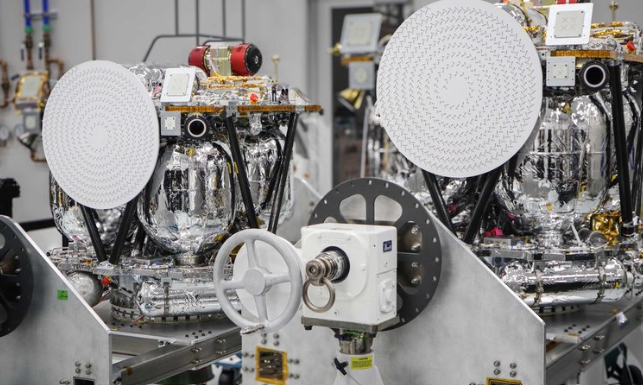- “ESCAPADE is a trailblazer for a new era of small planetary missions, demonstrating that we can achieve big science on a smaller budget.” — Jim Green, former NASA Chief Scientist
- “By sending two small spacecraft to Mars, we’re maximizing our ability to uncover the mysteries of the Martian atmosphere and its interaction with solar wind.” — Dan Baker, ESCAPADE Principal Investigator
NASA’s twin ESCAPADE spacecraft, designed by Rocket Lab to study the Martian magnetosphere, have arrived in Florida in preparation for their upcoming launch this fall on Blue Origin’s inaugural New Glenn rocket flight. The small satellites were shipped from Rocket Lab’s Long Beach, California, facility and will soon undergo final pre-launch processing.
The ESCAPADE mission, set to explore the interaction between the solar wind and Mars’ magnetosphere, marks a significant milestone as it prepares for launch. Although specific launch dates have not been disclosed, industry insiders suggest an October timeframe, contingent on New Glenn’s readiness.
NASA’s ESCAPADE Mission: Launch Countdown Begins For Mars Exploration — Two NASA spacecraft built by Rocket Lab are on the road from California to Florida this weekend to begin preparations for launch on Blue Origin’s https://t.co/w2AglYKuf3 pic.twitter.com/FSgZTxDaDW
— System Publisher (@sypuber) August 20, 2024
Rocket Lab’s team, led by systems engineer Christophe Mandy, will conduct performance tests on the spacecraft to ensure they are intact after transit. The process also includes loading the spacecraft with necessary gases and propellants. After launching, New Glenn will deploy the ESCAPADE spacecraft into an extended Earth orbit. From there, the spacecraft will use their own thrusters to journey to Mars, arriving about 11 months later.
The development of ESCAPADE was challenging due to the initial uncertainty of the launch vehicle, requiring Rocket Lab to design the mission with a broad range of possible launch options in mind. Despite these challenges, Rocket Lab successfully adapted, integrating high-efficiency designs and leveraging components from various sources, including ArianeGroup’s main engines.
Each spacecraft, named Blue and Gold after the University of California Berkeley’s colors, weighs 524 kilograms, with most of that weight dedicated to propellant. Rocket Lab’s experience with ESCAPADE is feeding into its broader space systems business, which includes projects for Varda Space Industries and the Space Development Agency.
🛰️🛰️ Ready for Mars! We’ve shipped our twin spacecraft, Blue and Gold, off for launch in Cape Canaveral, Florida to enable @ucbssl and @NASA‘s ESCAPADE mission! Designed & built by our team, these spacecraft will help unravel Mars’ magnetic fields & plasma mysteries. Learn more… pic.twitter.com/qe4N8Ll0ez
— Rocket Lab (@RocketLab) August 16, 2024
Rocket Lab’s work on ESCAPADE reflects a quick turnaround, completing the mission in just three and a half years—a significant achievement given that Mars missions typically take a decade. This efficiency will be applied to future missions, as the company continues to refine its processes and build on its growing portfolio of space systems.
Quotes and Facts…
- Mission Objective: ESCAPADE aims to study the dynamics of Mars’ magnetosphere and how it interacts with the solar wind. The mission will help scientists understand the processes that have stripped away Mars’ atmosphere, leading to its current dry and barren state.
- Twin Spacecraft: ESCAPADE consists of two identical spacecraft, named “Blue” and “Gold,” which will orbit Mars in a coordinated manner. This dual approach allows for simultaneous measurements at different locations, providing a comprehensive view of Mars’ magnetic field and atmospheric escape.
- Innovative Design: ESCAPADE is a small-scale mission, part of NASA’s SIMPLEx (Small Innovative Missions for Planetary Exploration) program. It demonstrates the growing capability of small, cost-effective spacecraft to conduct high-value science.
- Launch and Timeline: The ESCAPADE mission is scheduled for launch in 2024, with the spacecraft expected to reach Mars in 2025. It will be launched as a secondary payload aboard a larger rocket.
- Scientific Goals: By measuring the magnetic and electric fields, as well as charged particles around Mars, ESCAPADE will provide data crucial for understanding the planet’s atmospheric evolution and its potential habitability in the past.
- “ESCAPADE’s mission to Mars is a testament to how innovation in spacecraft design can unlock new doors in planetary exploration.” — Thomas Zurbuchen, NASA’s former Associate Administrator for the Science Mission Directorate
- “Understanding how Mars’ atmosphere has changed over time will give us crucial insights into the history of water on the planet and its potential to support life.” — Janet Luhmann, Space Physicist at UC Berkeley
Key Points:
i. NASA’s ESCAPADE spacecraft have arrived in Florida for pre-launch preparations on Blue Origin’s New Glenn rocket.
ii. The mission will study the interaction of solar wind with Mars’ magnetosphere, with a launch expected in October.
iii. Lab designed the spacecraft with a flexible approach, accommodating various potential launch vehicles.
iv. ESCAPADE mission was developed in just three and a half years, significantly faster than typical Mars missions.
v. Rocket Lab is applying lessons learned from ESCAPADE to other space systems projects, including work with Varda Space Industries and the Space Development Agency.
TL Holcomb – Reprinted with permission of Whatfinger News



